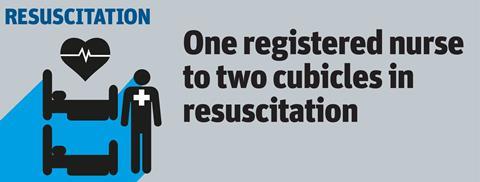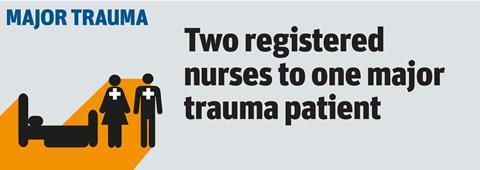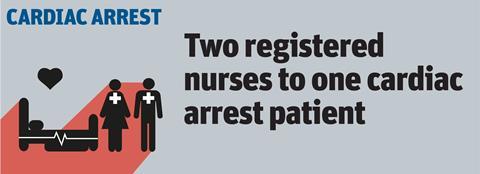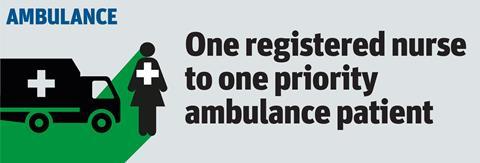- Guidelines for A&E safe staffing, leaked to HSJ, recommended minimum nurse/patient ratios
- Documents suggest lower nursing numbers linked to poor patient outcomes
- Ratio recommendations were made despite government resistance
- Read the guidance
Suppressed NICE safe staffing guidance for hospital emergency departments called for the NHS to implement minimum nurse ratios to ensure safe care, HSJ reveals today.

The National Institute for Health and Care Excellence’s unpublished final report on emergency department safe staffing, kept secret for months, has been leaked to HSJ alongside a number of related reports.
The guidance, reproduced by HSJ, shows NICE’s safe staffing committee pressed ahead with recommending minimum nurse ratios in English accident and emergency departments despite opposition to the idea of minimum ratios in government and senior NHS circles.

Shortly after the guideline was completed, last June NHS England controversially suspended NICE’s safe staffing work, which left areas such as mental health and community nursing without advice.The guideline, published today, said all “type 1” A&E departments, which includes most in England, should provide, as a minimum:
- one registered nurse to one cubicle in triage;
- one registered nurse to four cubicles in majors;
- one registered nurse to two cubicles in resuscitation;
- two registered nurses to one major trauma patient;
- two registered nurses to one cardiac arrest patient; and
- one registered nurse to one priority ambulance patient.

It also recommended that every A&E shift should have a registered children’s nurse, or at least a nurse trained in caring for children. Each shift should also have a band 7 nurse “to lead, supervise and oversee the shift”. An appendix to the guideline – also reproduced by HSJ – said such a role is “associated with higher levels of safe care”.
In a change from its draft guideline, the safe staffing committee decided against setting a minimum ratio for nurses working in the minors area of A&E.
An external study, carried out for NICE, looked at the effects of different scenarios on a model A&E department. It found that a “low nursing skill mix and low staff numbers will have a negative impact on outcomes (more patients leaving without being seen, higher average duration in A&E departments and higher occupancy)” and that “moving towards a higher average skill mix of nurses might improve some patient and process outcomes”.

The guideline said: “Minimum ratios for areas of the A&E department and registered nurse-to-patient ratios for particular situations are recommended in this guideline based on the evidence available and the safe staffing advisory committee’s knowledge and experience.”
It said the document was designed for trusts to “ensure that patients attending A&E departments receive the nursing care they need at all times of the day and night, on weekdays and at weekends”.

While the ratios “should be used as a minimum”, the guidance said these were not fixed and additional staff could be used above the minimum levels based on local professional judgement.
The guidance also recommended a systematic process for senior nurses to calculate staffing levels and suggested a system of “red flag” events to serve as a “warning sign that something may be wrong with nursing staff levels”.
These events include: a crowded department; missing patients; aggression towards staff; falls; and patients leaving the department against advice. Other red flag incidents include delays of more than 30 minutes for giving pain relief or food and drink, and a more than a 10 minute delay in helping patients use the toilet.

The decision to suspend NICE’s safe staffing work was criticised by high profile figures including Sir Robert Francis QC, who recommended that NICE carry out the work following his public inquiry into failings at the Mid Staffordshire Foundation Trust.
In 2013, health secretary Jeremy Hunt rejected the suggestion of minimum nurse-to-patient ratios. Then in July 2015 he said at a King’s Fund event he “never wanted” mandatory nurse ratios from NICE’s work on safe staffing.

NHS England chief nursing officer Jane Cummings has also argued against minimum ratios, instead preferring a multidisciplinary staffing focus, though it is unclear how this would look and operate.
NHS Improvement is developing guidance on safe staffing levels that is expected to be published this year. Mr Hunt has said this will be reviewed by Sir Robert, NICE and chief inspector of hospitals Sir Mike Richards.
A spokeswoman for the Department of Health said the document should not be treated as official guidance adding: ”A comprehensive programme of work on safe staffing is being led by NHS Improvement and full guidance will be published later this year.”

In a statement NICE said: ”NICE hasn’t published guidance on safe staffing in accident and emergency departments and doesn’t intend to do so.”
Exclusive: NICE experts called for minimum staff ratios in leaked guidance
- 1
 Currently reading
Currently readingExclusive: NICE experts called for minimum staff ratios in leaked guidance
- 2
- 3
- 4
- 5
- 6
































4 Readers' comments